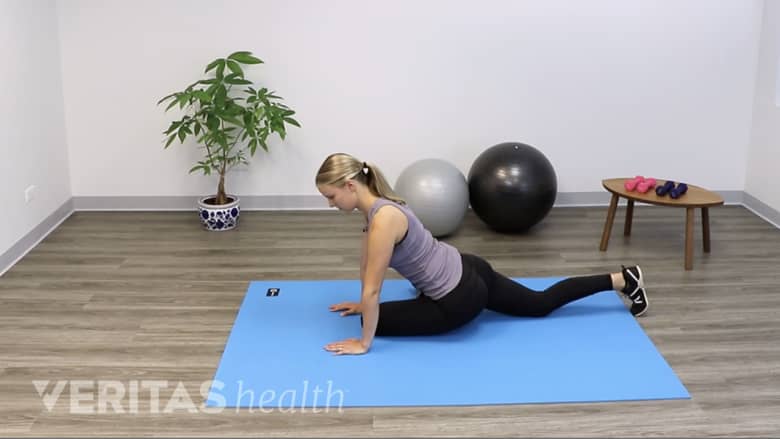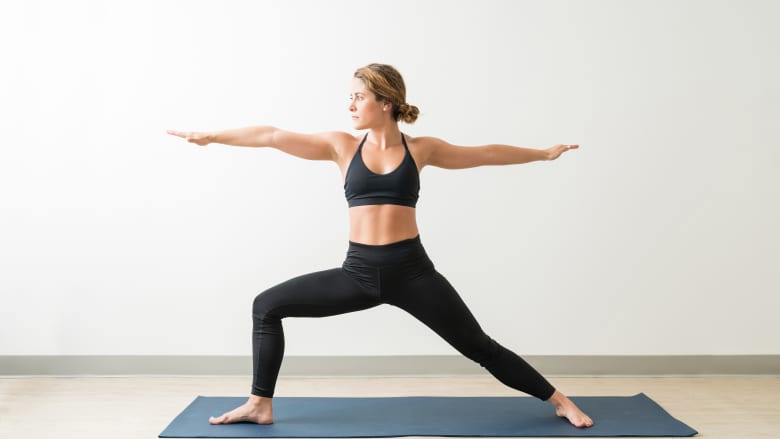Static and dynamic yoga postures can help reduce piriformis syndrome pain by strengthening and stabilizing your core muscles, increasing flexibility in your hip and spine, and preventing future recurrence of pain.1Rathore M, Trivedi S, Abraham J, Sinha MB. Anatomical Correlation of Core Muscle Activation in Different Yogic Postures. Int J Yoga. 2017;10(2):59–66. Available from: https://www.ncbi.nlm.nih.gov/pmc/articles/PMC5433114/,2Monro R, Bhardwaj AK, Gupta RK, Telles S, Allen B, Little P. Disc extrusions and bulges in nonspecific low back pain and sciatica: Exploratory randomised controlled trial comparing yoga therapy and normal medical treatment. J Back Musculoskelet Rehabil. 2015;28(2):383-92. http://doi.org/10.3233/BMR-140531
Benefits of yoga for piriformis syndrome
Piriformis syndrome occurs when the piriformis muscle deep in the buttock becomes weak due to overuse. The weak muscle begins to spasm and causes buttock pain, hip pain, and sciatica-like leg pain. When the buttock muscles are weak, they can cause a cascading effect on the back muscles, which can become weak and painful over time.3Lehecka BJ, Stoffregen S, May A, et al. Gluteal Muscle Activation During Common Yoga Poses. Int J Sports Phys Ther. 2021;16(3):662-670. Published 2021 Jun 1. http://doi.org/10.26603/001c.22499
Read: Is Piriformis Syndrome the Same Thing as Sciatica?
For this reason, strengthening and stretching the muscles in both these regions can provide an overall benefit and a more effective treatment outcome. In addition to activating the lower back and gluteal muscles, yoga also helps improve overall mind-body awareness and relaxation. The key to effective yoga practice is to maintain steady, deep breaths, and focus on the body part being stretched.
Yoga for piriformis syndrome also helps strengthen other buttock muscles, such as the large gluteus maximus and gluteus medius muscles.
Watch Got Buttock Pain? Discover What’s Causing It and How to Fix It Video
Here are 4 easy and effective yoga stretches for piriformis muscle pain and back pain that you can do at home using a yoga mat.
Pigeon pose
The pigeon pose stretches the deep gluteal muscles, such as the piriformis muscle, and the hip extensor muscles, such as the gluteus maximus and the hamstrings.4Fishman L. Healing Yoga: Proven Postures to Treat Twenty Common Ailments – from Backache to Bone Loss, Should Pain to Bunions, and More. W.W. Norton & Company; 2015.,5Kushner AM, Brent JL, Schoenfeld BJ, et al. The Back Squat Part 2: Targeted Training Techniques to Correct Functional Deficits and Technical Factors that Limit Performance. Strength Cond J. 2015;37(2):13-60. http://doi.org/10.1519/SSC.0000000000000130 To perform the pigeon pose, begin on all fours, with hands and knees positioned under the shoulders and hips, respectively.
- Bend one knee and tuck the leg underneath the body.
- Fold the body over the top of the bent leg.
- Keep the opposite leg stretched out straight with toes pointing to the floor.
- Reach forward, as much as possible, without pain.
Hold the pose for 5 deep breaths and slowly return to the starting position. Aim to complete one set of three stretches on each side.
Triangle pose
The triangle pose focuses on stretching the back in a side-bent position while keeping the feet wide apart. The triangle pose improves mobility in the spine, elongates the muscles in the back, and reduces stiffness in the lower back and hip. To perform the triangle pose, stand with feet 3-4 feet apart, the left foot turned out 90°, and arms stretched out horizontally.6Kumar A, Kapse RC, Paul N, Vanjare AM, Omkar SN. Musculoskeletal Modeling and Analysis of Trikonasana. Int J Yoga. 2018;11(3):201-207. http://doi.org/10.4103/ijoy.IJOY_1_18
- Take a deep breath and as you exhale, bend your upper body sideways toward your left side until your left hand rests on your left shin bone and your right hand is extended upwards with the fingers pointing to the ceiling.
- Ensure that your hips are facing forward and not rotated.
- Pull the shoulder blades back and lengthen the spine.
- If resting the hand on the shin is difficult. Place one or two yoga blocks near the left foot and place your hand on the yoga block.
Hold the pose for 30 seconds while taking steady, deep breaths, and repeat on the opposite side. Aim to complete one set of three stretches on each side.
Tree pose
The tree pose focusses on the large gluteus maximus and gluteus medius muscles of the buttock and help maintain balance and equilibrium in the body. To perform the tree pose, stand straight with palms facing the body.7Lehecka BJ, Stoffregen S, May A, et al. Gluteal Muscle Activation During Common Yoga Poses. Int J Sports Phys Ther. 2021;16(3):662-670. Published 2021 Jun 1. http://doi.org/10.26603/001c.22499
To perform the tree pose, stand straight with palms facing the body.
- Bring your palms together near your chest.
- Shift your weight to the left side and gently lift your right foot off the ground and place the sole of your foot on the inner side of the left leg.
- You may place your right sole near the left ankle, left knee, or left thigh—whichever feels comfortable.
- Turn your knee outwards as far as it can go without losing balance.
- Ensure that your hips are facing forward and not rotated.
Hold the pose for 30 seconds while taking steady, deep breaths, and repeat on the opposite side. Aim to complete one set of three stretches on each side.
Warrior pose
The warrior pose helps activate and strengthen the buttock muscles.8Dacci P, Amadio S, Gerevini S, et al. Practice of yoga may cause damage of both sciatic nerves: a case report. Neurol Sci. 2013;34(3):393-6. http://doi.org/10.1007/s10072-012-0998-9
To perform the warrior pose, stand straight with your feet 3-4 feet apart.
- Turn your right toes outward, facing the right direction.
- Bend your right knee directly over your right ankle as you lean to the right side.
- Straighten your left knee.
- Raise both arms so they are parallel to the floor with palms facing down.
- Turn your neck to the right to help lengthen the spine.
- Tighten your abdominal muscles and maintain a straight, long spine.
Hold the pose for 30 seconds while taking steady, deep breaths, and repeat on the opposite side. Aim to complete one set of three stretches on each side.
Can yoga irritate the piriformis muscle: Precautions while performing yoga
If you take medication(s) that may cause sedation or make you drowsy or have a medical condition that causes your ligaments and joints to be more flexible than normal (hypermobile), yoga must be avoided or practiced under the guidance of a therapist.8Dacci P, Amadio S, Gerevini S, et al. Practice of yoga may cause damage of both sciatic nerves: a case report. Neurol Sci. 2013;34(3):393-6. http://doi.org/10.1007/s10072-012-0998-9
Yoga can be an effective, low-impact way to find relief from piriformis syndrome pain. Often, a particular pose may help one person, but it may not work for others. You may need to try different yoga poses to find the most effective stretch to relieve your buttock pain. When in doubt about a pose or if a yoga posture causes sudden pain, it is advisable to seek medical help.
The poses themselves may be uncomfortable, particularly at first, but careful, gentle, and gradually progressive practice can help alleviate the uncomfortable symptoms of piriformis pain.
Read more about Piriformis Syndrome Treatment
Learn more:
2 Essential Stretches to Relieve Piriformis Syndrome Symptoms
- 1 Rathore M, Trivedi S, Abraham J, Sinha MB. Anatomical Correlation of Core Muscle Activation in Different Yogic Postures. Int J Yoga. 2017;10(2):59–66. Available from: https://www.ncbi.nlm.nih.gov/pmc/articles/PMC5433114/
- 2 Monro R, Bhardwaj AK, Gupta RK, Telles S, Allen B, Little P. Disc extrusions and bulges in nonspecific low back pain and sciatica: Exploratory randomised controlled trial comparing yoga therapy and normal medical treatment. J Back Musculoskelet Rehabil. 2015;28(2):383-92. http://doi.org/10.3233/BMR-140531
- 3 Lehecka BJ, Stoffregen S, May A, et al. Gluteal Muscle Activation During Common Yoga Poses. Int J Sports Phys Ther. 2021;16(3):662-670. Published 2021 Jun 1. http://doi.org/10.26603/001c.22499
- 4 Fishman L. Healing Yoga: Proven Postures to Treat Twenty Common Ailments – from Backache to Bone Loss, Should Pain to Bunions, and More. W.W. Norton & Company; 2015.
- 5 Kushner AM, Brent JL, Schoenfeld BJ, et al. The Back Squat Part 2: Targeted Training Techniques to Correct Functional Deficits and Technical Factors that Limit Performance. Strength Cond J. 2015;37(2):13-60. http://doi.org/10.1519/SSC.0000000000000130
- 6 Kumar A, Kapse RC, Paul N, Vanjare AM, Omkar SN. Musculoskeletal Modeling and Analysis of Trikonasana. Int J Yoga. 2018;11(3):201-207. http://doi.org/10.4103/ijoy.IJOY_1_18
- 8 Dacci P, Amadio S, Gerevini S, et al. Practice of yoga may cause damage of both sciatic nerves: a case report. Neurol Sci. 2013;34(3):393-6. http://doi.org/10.1007/s10072-012-0998-9
Editor’s Top Picks
- One-minute Stretch For Piriformis Pain Relief (Gentle, For Beginners) Video
- Stretches and Exercise for Sciatic Pain from Piriformis Syndrome
- Got Buttock Pain? Discover What’s Causing It and How to Fix It Video
- Piriformis Muscle Anatomy Animation
- Piriformis Syndrome Video
- 4 Easy Stretches For Piriformis Syndrome Pain Relief Video









